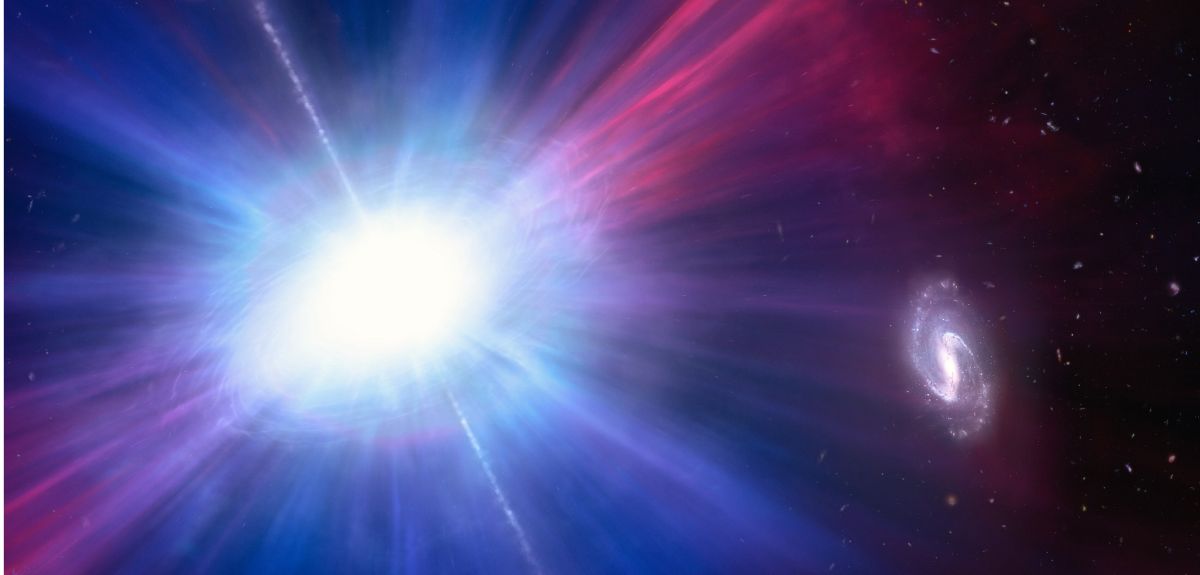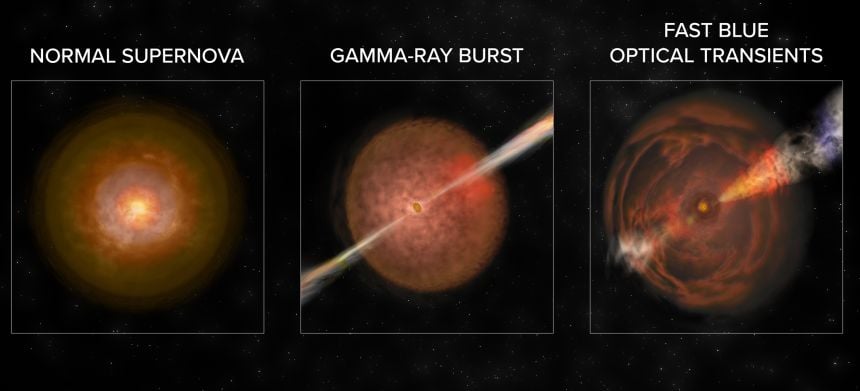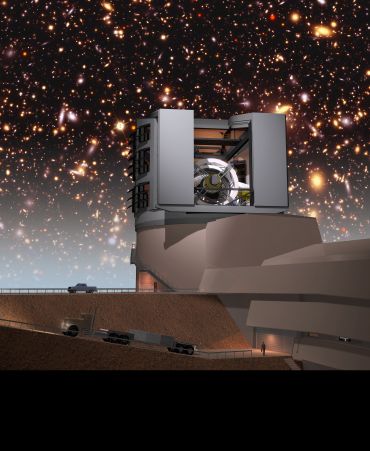
Extraordinary new space phenomenon mystifies scientists
Astrophysicists at the University of Oxford have helped to discover a spectacularly bright and unusual explosion in a galaxy 4.4 billion light-years away. The findings have been published in the journal Nature.
It is a remarkable and unexpected discovery, but the fact that the flares were detected by a number of instruments proves it is a real, astrophysical phenomenon. The fast variability of the flares indicates that an object of small size is producing them, probably a black hole. We hope more theoretical work will enable us to understand this emission better.
Professor Stephen Smartt, Department of Physics, University of Oxford.
Since they were first discovered in 2018, astronomers have been fascinated by fast blue optical transients (FBOTs): extremely hot explosions in outer space, and amongst the brightest known optical phenomena in the universe. But with only a handful of FBOTs discovered to date, the mechanisms causing these super-bright events have remained a mystery.
Like supernovae, one theory for the origin of FBOTs is when stars much larger than our Sun explode at the end of their life. But whilst supernovae light up then fade gradually over weeks or months, FBOTs evolve much more rapidly, reaching peak brightness then fading again in a matter of days. FBOTs are also much brighter, with up to 10 to 100 times the luminosity of a typical supernova.
On 7 September 2022, a new FBOT (subsequently named AT2022tsd, the “Tasmanian Devil”) was discovered which displayed even more unusual behaviour. Instead of the light fading away, it peaked again several times after the initial explosion over extremely short minutes-long timescales. Each of these flares was extremely energetic, reaching supernovae-like intensities.
Professor of Astrophysics Stephen Smartt (Department of Physics, University of Oxford), who helped discover AT2022tsd, said: ‘We have discovered an unusual event that has never been seen before, but data from many telescopes confirm these flares are real. It is unprecedented to observe flares this bright over such short timescales – like a candle stuttering in outer space. How can an object become so luminous again so quickly? This is now our challenge to work out.’AT2022tsd was initially captured during a routine optical survey by the Zwicky Transient Facility at the Palomar Observatory in California. The event was then confirmed by other observatories and data worldwide, including data from the Pan-STARRS telescope survey in Hawaii. Professor Smartt is the scientific lead of the search for distant explosions with Pan-STARRS and his team analyse the data for unusual sources on a daily basis. Following this, a network of 13 telescopes across the world recorded 14 flaring events over a period of 100 days.
According to the researchers, these flares may be caused by ejections of material being accelerated to near-light speeds (known as relativistic jets). These are thought to occur when material interacts with the magnetic field of an extremely compact object, such as a neutron star or black hole.

Professor Smartt said: ‘According to computer simulations, when material falls in towards a blackhole, it forms a flattened, spinning circular structure called an accretion disc. This can propel jets of material at extremely fast speeds. Potentially, the core of the star which caused AT2022tsd collapsed to form a black hole, and material surrounding the core was ejected in the form of stuttering jets.’
`An alternative and plausible theory is that an already existing black hole gravitationally shreds a star in close orbit around it. Again, a spinning disk can be formed and a jet launched in this model. I think the jet model for the very short and luminous emission is likely, but the question remains as to what causes the jet. Most of the physical models involve a black hole of some sort – either pre-existing or formed at the time the object was discovered.’
Dr Andrew Mummery, (Department of Physics, University of Oxford), an expert in the physical theories describing the accretion process around black holes, said: 'The small but growing population of explosions such as AT2022tsd are a fascinating new astronomical phenomenon. Detailed observational campaigns such as this are vital to theorists trying to understand fundamental questions such as how exactly black holes form when massive stars die, or how black holes tidally shred stars.'In June 2018, Professor Smartt discovered the first FBOT, AT2018cow: an unprecedently bright astronomical explosion in a galaxy 200 million light-years away in the constellation of Hercules.
‘When we discovered AT2018cow, I realised within a few days that this was a new type of transient in the universe that we hadn’t known about’ he said. ‘It radiated from X-ray to radio, faded rapidly, was brighter than normal supernovae, and ejected high speed material. It was very exciting to be part of that discovery process. The object AT2022tsd looks quite similar, but the rapid flares are quite unexpected and remarkable.’
Professor Smartt added: ‘We are continuing to search for these objects in our daily sky survey data. With our colleagues at the University of Hawaii, we assist in running the NASA all-sky surveys (Pan-STARRS and ATLAS). At Oxford we find the sources and trigger large telescopes around the world, including the radio facilities that Oxford run. We will discover more of these with the Rubin Observatory, the world’s largest survey facility being built in Chile. A very important part of this is working with our theory colleagues at Oxford such as Dr Andy Mummery to understand the physics and origin of these remarkable objects.’
The study ‘Minutes-duration Optical Flares with Supernova Luminosities’ has been published in Nature. The study was led by Cornell University.


 Cambridge victorious in Women's and Men's Boat Races 2025
Cambridge victorious in Women's and Men's Boat Races 2025
 Expert Comment: Ethical and legal challenges of uterus transplants in Mexico
Expert Comment: Ethical and legal challenges of uterus transplants in Mexico
 Oxford Humanities team delivers framework for tackling modern slavery and human trafficking
Oxford Humanities team delivers framework for tackling modern slavery and human trafficking